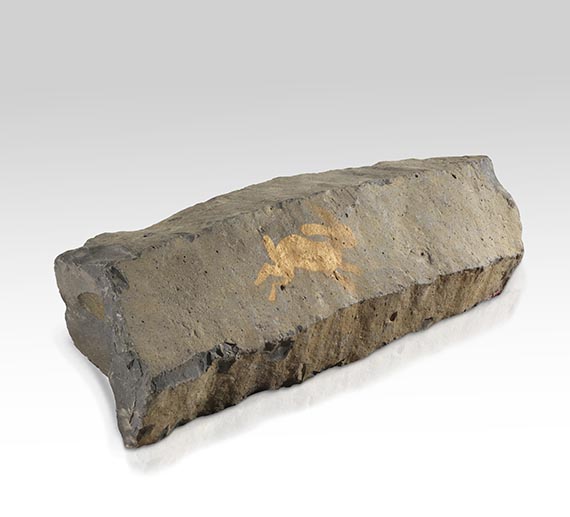Altre immagini
Altre immagini
143
Joseph Beuys
Hasenstein, 1982.
Multiple. Basalt stone with golden spray paint ...
Stima:
€ 40,000 / $ 46,800 Risultato:
€ 120,650 / $ 141,160 ( commissione inclusa)
Hasenstein. 1982.
Multiple. Basalt stone with golden spray paint and painted in pink.
Signed, numbered and inscribed oin the side. From an edition of 7 large stones. 35 x 110 x 33 cm (13.7 x 43.3 x 12.9 in).
Published by Edition Staeck, Heidelberg. [KT].
• Extraordinary materiality and monumentality.
• Beuys is a master of complex symbolism: the combination of the color gold, the hare and the primal basalt rock make up his inimitable mythology.
• In his first highly acclaimed performance in 1965, "Wie man dem toten Hasen die Bilder erklärt" (How to explain the pictures to the dead hare) as well as in "Goldhase" at documenta VII in 1982 , Beuys made gold and the hare a central motif in his work.
• Very rarely offered on the auction market (source: artprice.com).
PROVENANCE:
Private collection Berlin.
EXHIBITION:
Beuys - Lehmbruck: Denken ist Plastik, Bundeskunsthalle, Bonn, June 25 - November 20, 2021, pp. 66-67 (double-page illu.).
LITERATURE:
Jörg Schellmann, Joseph Beuys. Die Multiples: Werkverzeichnis der Auflagenobjekte und Druckgraphik 1965-1986, Munich/New York 1992, no. 460 B (illu., different cop).
"For me, the hare is a symbol of incarnation, because the hare does in reality what humans can only do in thought. It digs itself in, it digs its hole. It incarnates into the ground, and that alone is important. That's how it appears to me."
Quoted from Götz Adriani et al, Joseph Beuys Leben und Werk, Cologne 1984, p. 155.
Multiple. Basalt stone with golden spray paint and painted in pink.
Signed, numbered and inscribed oin the side. From an edition of 7 large stones. 35 x 110 x 33 cm (13.7 x 43.3 x 12.9 in).
Published by Edition Staeck, Heidelberg. [KT].
• Extraordinary materiality and monumentality.
• Beuys is a master of complex symbolism: the combination of the color gold, the hare and the primal basalt rock make up his inimitable mythology.
• In his first highly acclaimed performance in 1965, "Wie man dem toten Hasen die Bilder erklärt" (How to explain the pictures to the dead hare) as well as in "Goldhase" at documenta VII in 1982 , Beuys made gold and the hare a central motif in his work.
• Very rarely offered on the auction market (source: artprice.com).
PROVENANCE:
Private collection Berlin.
EXHIBITION:
Beuys - Lehmbruck: Denken ist Plastik, Bundeskunsthalle, Bonn, June 25 - November 20, 2021, pp. 66-67 (double-page illu.).
LITERATURE:
Jörg Schellmann, Joseph Beuys. Die Multiples: Werkverzeichnis der Auflagenobjekte und Druckgraphik 1965-1986, Munich/New York 1992, no. 460 B (illu., different cop).
"For me, the hare is a symbol of incarnation, because the hare does in reality what humans can only do in thought. It digs itself in, it digs its hole. It incarnates into the ground, and that alone is important. That's how it appears to me."
Quoted from Götz Adriani et al, Joseph Beuys Leben und Werk, Cologne 1984, p. 155.
143
Joseph Beuys
Hasenstein, 1982.
Multiple. Basalt stone with golden spray paint ...
Stima:
€ 40,000 / $ 46,800 Risultato:
€ 120,650 / $ 141,160 ( commissione inclusa)




 Lot 143
Lot 143 